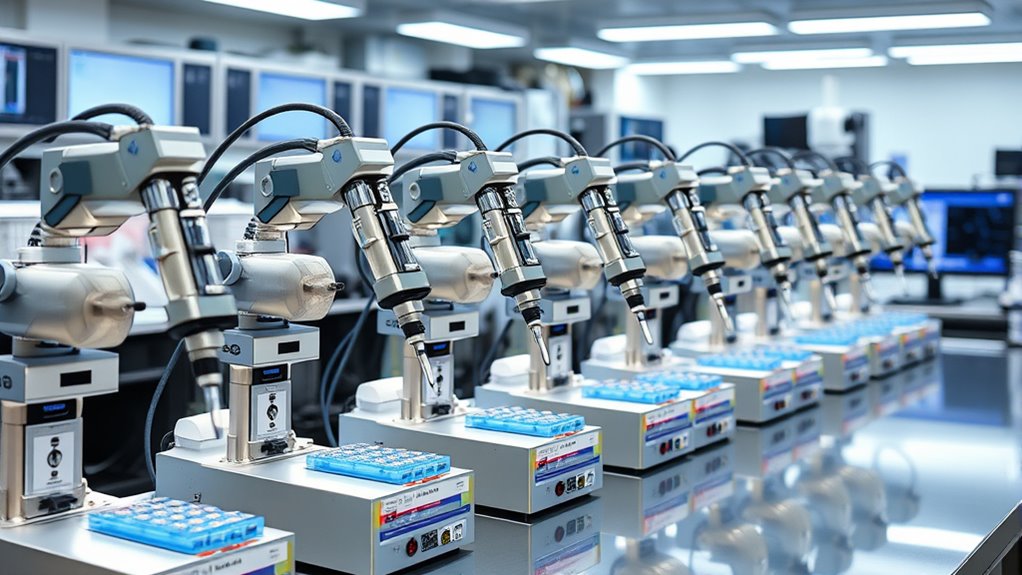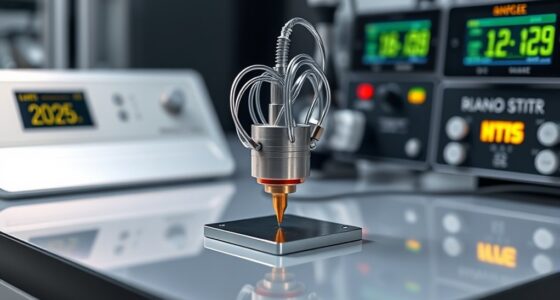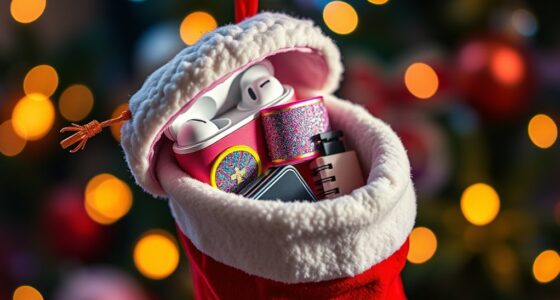If you’re looking for the 12 best automated pipetting systems of 2025, I’ve got you covered. These systems are designed for precision and efficiency, featuring adjustable controls, wide volume ranges, and user-friendly interfaces. From electronic pipettors and controllers to complete automated kits, they support diverse lab applications. Each system emphasizes reliability, contamination prevention, and compatibility with various tips and accessories. Keep going, and you’ll discover detailed insights to help you select the right solution for your needs.
Key Takeaways
- The list highlights top automated pipetting systems designed for high precision and efficiency in 2025.
- It includes features, compatibility, and design elements of advanced pipetting solutions.
- Emphasis on automation, calibration, sterilization, and connectivity for reliable liquid handling.
- Covers a range of accessories like filtered tips and robotic tips for diverse applications.
- Provides insights into power sources, ergonomic design, and user-friendly interfaces for optimal workflow.
Micropipette 0.5-5ml Adjustable Lab Pipette
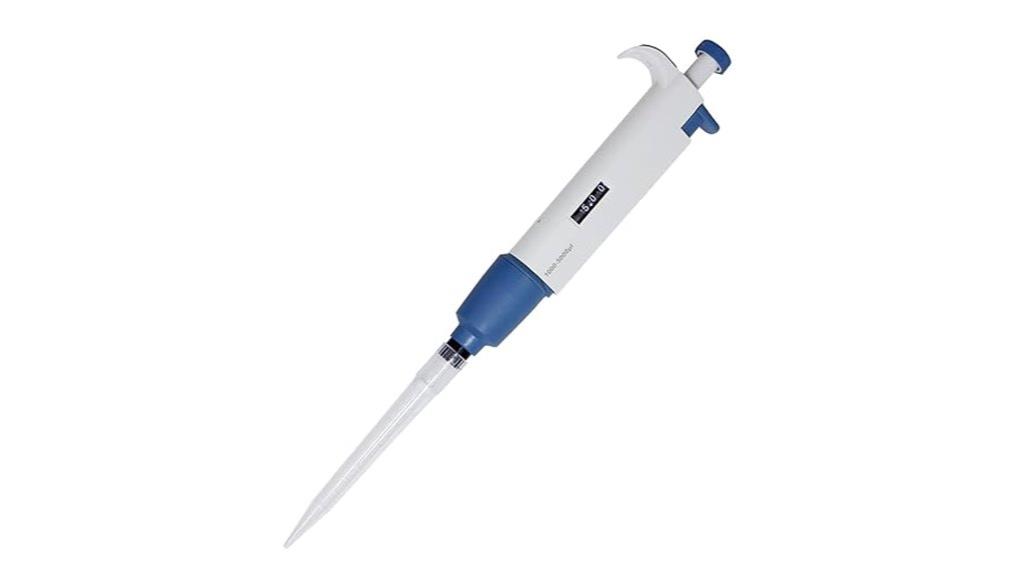
If you’re seeking a versatile and precise manual pipette for your laboratory work, the Micropipette 0.5-5ml Adjustable Lab Pipette is an excellent choice. I love how it offers a wide volume range, making it suitable for various applications. Its ergonomic, lightweight design reduces strain during prolonged use, and the clear 4-digit display ensures accurate volume setting. The universal tip cone guarantees compatibility with most tips, simplifying workflow. Plus, it’s half-autoclavable, allowing easy cleaning and sterilization. With calibration per ISO8655 standards and an individual test certificate, I trust its accuracy. It’s perfect for research, diagnostics, or everyday tasks requiring precise liquid measurement.
Best For: researchers, lab technicians, and hobbyists needing precise, versatile liquid handling in scientific, medical, or DIY applications.
Pros:
- Wide volume range (0.5-5ml) suitable for various tasks
- Ergonomic, lightweight design reduces fatigue during extended use
- Universal tip cone ensures compatibility with most pipette tips
Cons:
- May require calibration to maintain peak accuracy over time
- Disassembly for cleaning may be complex for some users
- Autoclaving is limited to 20 minutes at 121°C, which might not suit all sterilization needs
LAB FISH Electronic Pipettor for Laboratory (0.1~200ml, LCD, Rechargeable Battery)
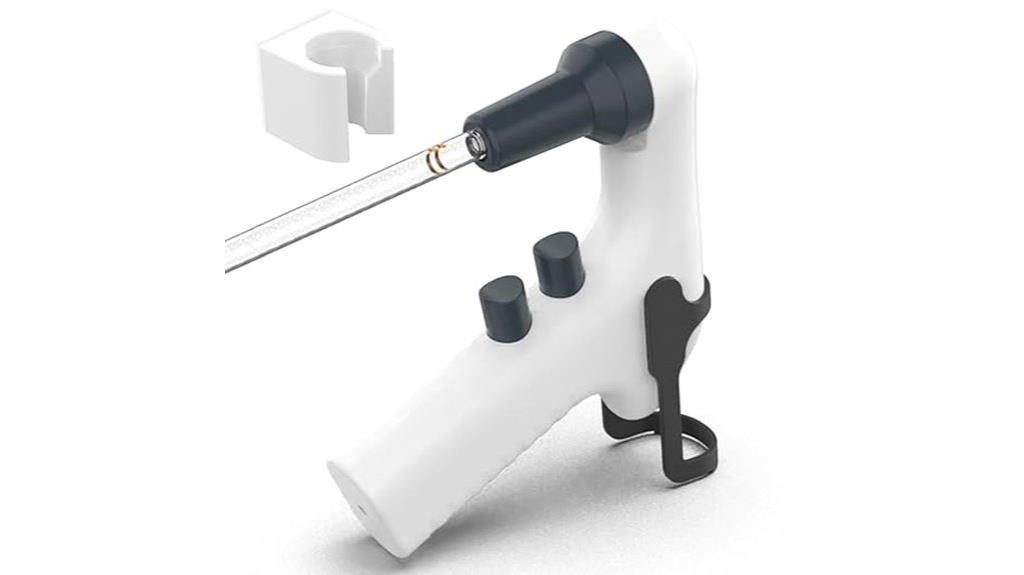
The LAB FISH Electronic Pipettor stands out for its impressive 0.1 to 200ml range, making it ideal for laboratories that handle a variety of liquid volumes. It features an LCD display, adjustable speeds across six levels, and a stable stand. Its sleek, professional design includes a conical nozzle for secure pipette attachment and spare nozzles for convenience. Equipped with a large-capacity lithium battery, it offers around 8 hours of intermittent use, though some users find the charging port inconvenient. Overall, it delivers reliable, precise pipetting for routine tasks, with easy one-button controls and durable construction.
Best For: researchers and laboratory technicians who need a versatile, reliable, and easy-to-use electronic pipettor for handling a wide range of liquid volumes in routine laboratory tasks.
Pros:
- Wide volume range of 0.1~200ml suitable for various applications
- LCD display and adjustable six-speed levels for precise control
- Durable construction with replaceable filters and nozzles for convenience
Cons:
- Non-USB-C charging port with an odd, thin DC jack that can be inconvenient to use
- Short battery life of approximately 8 hours with some users experiencing quick drainage
- Lacks automatic volume measurement and tactile feedback, requiring manual operation for each pipetting task
215905-0001 Automatic Pipette Washer Complete Kit
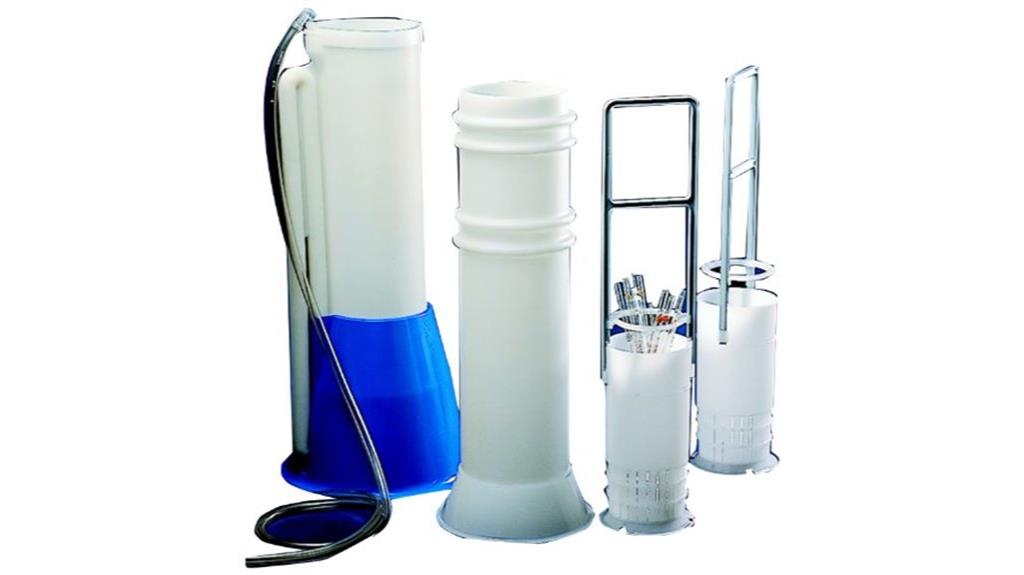
Looking for a reliable solution to streamline pipette cleaning? The 905-0001 Automatic Pipette Washer Complete Kit is exactly what you need. It washes pipettes quickly, safely, and effortlessly. The kit includes a pipette washer, basket, and jar, making setup straightforward. You simply soak dirty pipettes in the basket, transfer it to the washer, and it uses a steady flow of tap water to rinse thoroughly. This system accelerates cleaning, enhances safety, and simplifies maintenance. Designed by Dynalon®, it ensures efficient, consistent results with minimal effort—perfect for labs seeking precision and efficiency in pipette care.
Best For: laboratories and research facilities seeking a quick, safe, and efficient solution for pipette cleaning and maintenance.
Pros:
- Speeds up the pipette washing process, saving time.
- Ensures thorough cleaning with minimal effort and safety.
- Complete kit includes all necessary components for easy setup and operation.
Cons:
- May require a water supply connection for optimal performance.
- Suitable primarily for standard pipettes; may not accommodate specialized or oversized models.
- Dependence on tap water flow could affect cleaning consistency if water quality varies.
FOUR ES Scientific Adjustable Single-Channel Pipettor
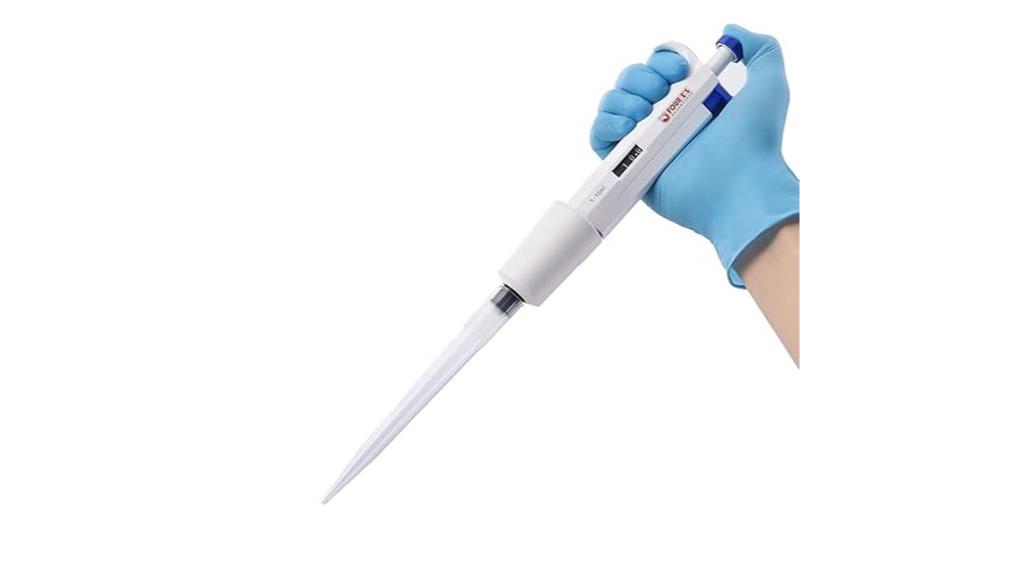
For researchers and technicians seeking a reliable, versatile pipette, the FOUR ES Scientific Adjustable Single-Channel Pipettor offers precise volume control from 1 to 10 ml with easy-to-read digital display. Its adjustable volume is set in 100 μl increments, ensuring accurate measurements across various applications. The lightweight handle reduces fatigue, and low plunger, tip attachment, and ejection forces minimize RSI risks. Designed for durability, it’s autoclavable at 121°C and resistant to chemicals like solvents, acids, and bases. Professionally calibrated to ISO8655 standards, it guarantees accuracy. Compatible with most universal tips, especially Four Es Scientific 10 ml micropipette tips, it’s ideal for lab, industrial, and even hobbyist use.
Best For: researchers, technicians, and hobbyists seeking precise, reliable liquid measurement in laboratories, industrial settings, or home projects.
Pros:
- Accurate volume control from 1 to 10 ml with digital display and 100 μl increments
- Ergonomic design reduces fatigue and minimizes RSI risk during repeated use
- Autoclavable and resistant to chemicals, ensuring durability and easy sterilization
Cons:
- Requires 12-hour cooling and drying time after autoclaving before reuse
- May be less suitable for very small volume measurements below 1 ml
- Compatibility limited to certain tips; may need adapters for non-standard tips
Micropipette Kit with Adjustable Single Channel Pipettors (3 Pieces)
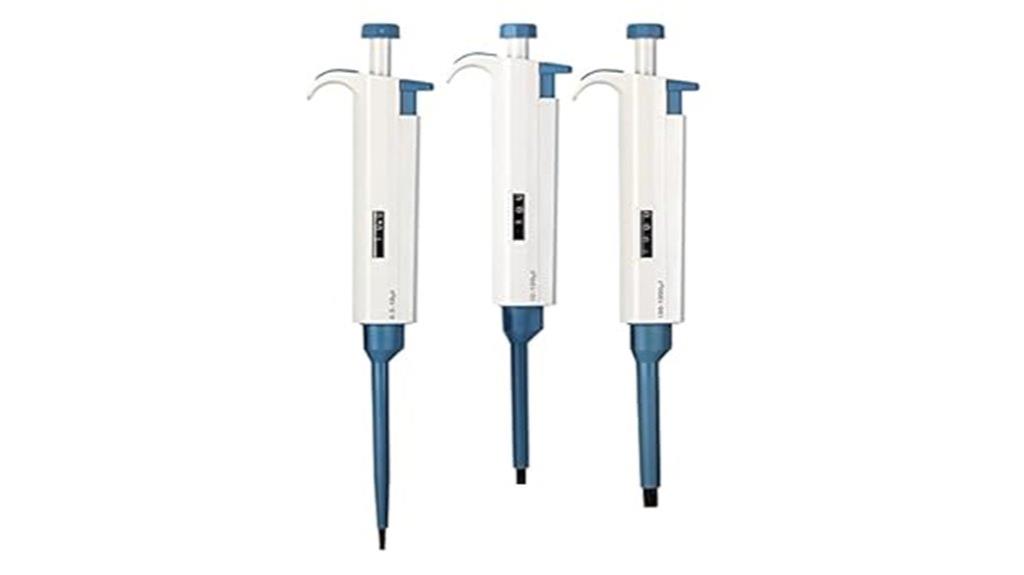
If you need versatile, precise pipetting tools suitable for a range of laboratory tasks, the Micropipette Kit with Adjustable Single Channel Pipettors from Huwazine is an excellent choice. This kit includes three pipettes covering volume ranges from 0.5μl to 10ml, ideal for various applications. The universal tip cone design guarantees broad tip compatibility. Its lightweight, ergonomic construction reduces fatigue, while the digital display allows for precise volume adjustments. Autoclavable and easy to calibrate, these pipettors meet ISO 8655 standards for accuracy. Overall, this kit offers reliable, versatile performance for any laboratory demanding precision.
Best For: researchers and laboratory technicians requiring precise, versatile pipetting tools across a wide range of sample volumes.
Pros:
- Broad volume range from 0.5μl to 10ml suitable for diverse applications
- Universal tip cone design ensures compatibility with most pipette tips
- Lightweight ergonomic design reduces fatigue during extended use
Cons:
- Requires manual calibration and maintenance for sustained accuracy
- Autoclaving disassembly may be time-consuming for some users
- Digital display and adjustment features may increase initial learning curve
Axygen OTF-180-R-S Filtered Robotic Pipet Tips for Oasis System
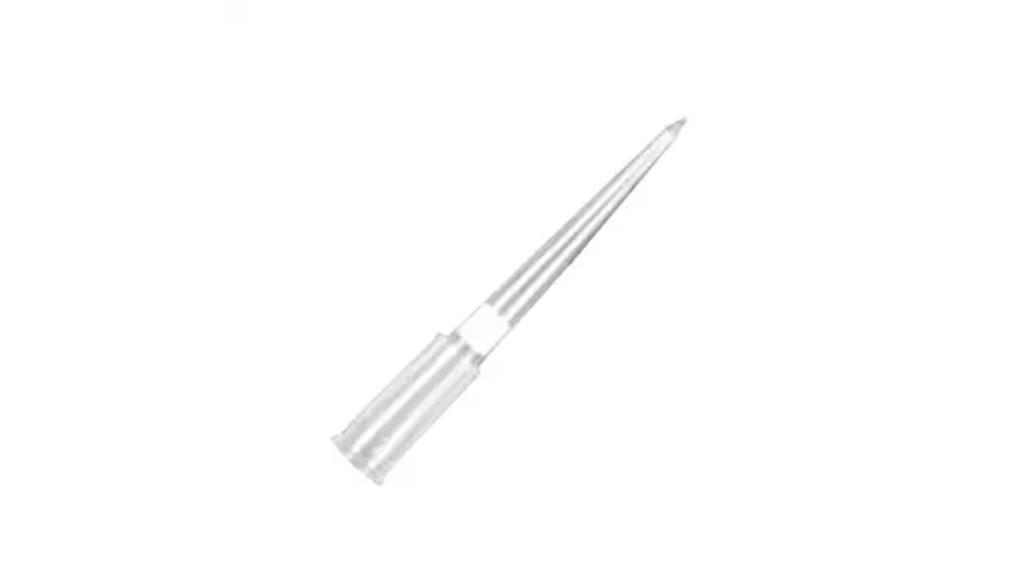
The Axygen OTF-180-R-S Filtered Robotic Pipet Tips are an excellent choice for laboratories utilizing the Oasis automated liquid handling system, especially when contamination prevention is a top priority. These tips have a 180-microliter capacity and feature built-in filters to prevent aerosol and liquid carryover. Made from clear polypropylene, they are pre-sterilized and come in a racked configuration for easy access and handling. Each case includes 96 racks with 10 racks per unit, simplifying inventory management. Designed specifically for automated systems, these tips ensure accurate, reliable pipetting while maintaining sterile conditions, making them ideal for sensitive or contamination-prone applications.
Best For: laboratories utilizing the Oasis automated liquid handling system that require sterile, contamination-free pipetting for sensitive applications.
Pros:
- Filtered tips prevent aerosol and liquid carryover, reducing contamination risk
- Pre-sterilized and racked for convenience and efficient workflow
- Compatible with Oasis system, ensuring accurate and reliable pipetting
Cons:
- Limited to 180 microliters capacity, which may not suit larger volume needs
- May be more expensive compared to non-filtered tips due to added filtration features
- Racked configuration may require specific storage arrangements
Lab Electric Pipette Controller (0.1-100ml) with LCD Screen and Adjustable Speed
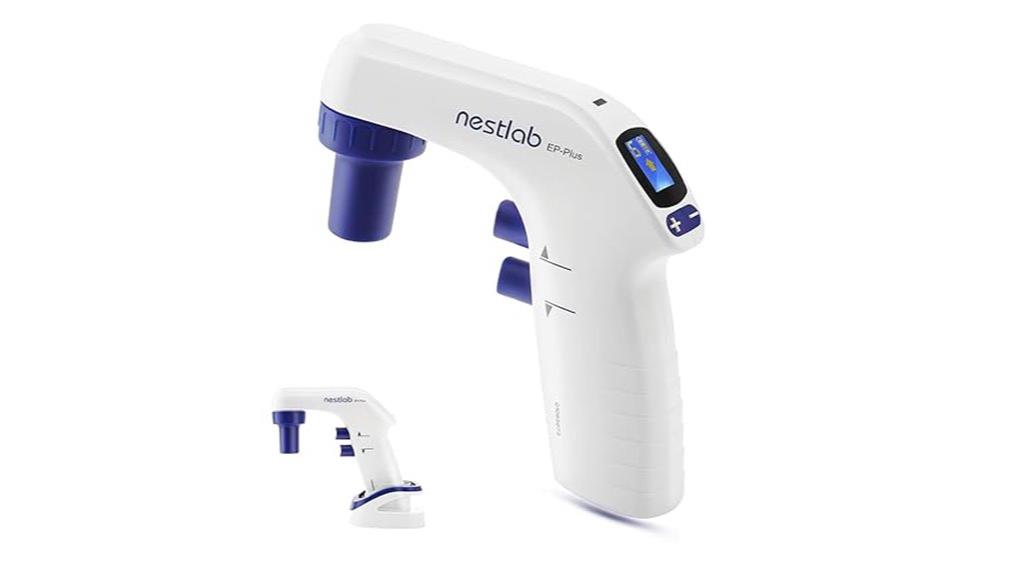
With its precise LCD screen and six adjustable speed settings, the Lab Electric Pipette Controller (0.1-100ml) stands out as an ideal choice for laboratory professionals who demand accurate and versatile liquid handling. It supports both plastic and glass pipettes, accommodating a wide range of experiments. The dual drainage modes—motorized and gravity—offer added flexibility, while the rechargeable lithium battery provides up to 8 hours of continuous use with quick charging. Its LCD display shows suction speed and remaining charge, ensuring smooth operation. Additionally, the 0.45μm filter membrane prevents contamination, making it a reliable and cost-effective tool for efficient pipetting workflows.
Best For: laboratory professionals seeking precise, versatile, and cost-effective liquid handling tools for a wide range of experimental applications.
Pros:
- Accurate control with six adjustable speed settings and clear LCD display
- Compatible with both plastic and glass pipettes for diverse laboratory needs
- Long battery life of up to 8 hours with quick charging and convenient USB-C recharging
Cons:
- No warranty information provided, which may concern some users
- Limited to a 0.1-100ml volume range, not suitable for larger volumes
- Absence of advanced connectivity features such as Bluetooth or data logging
Axygen OT-205-WB-R Robotic Pipet Tips for Oasis Automated Liquid Handling System
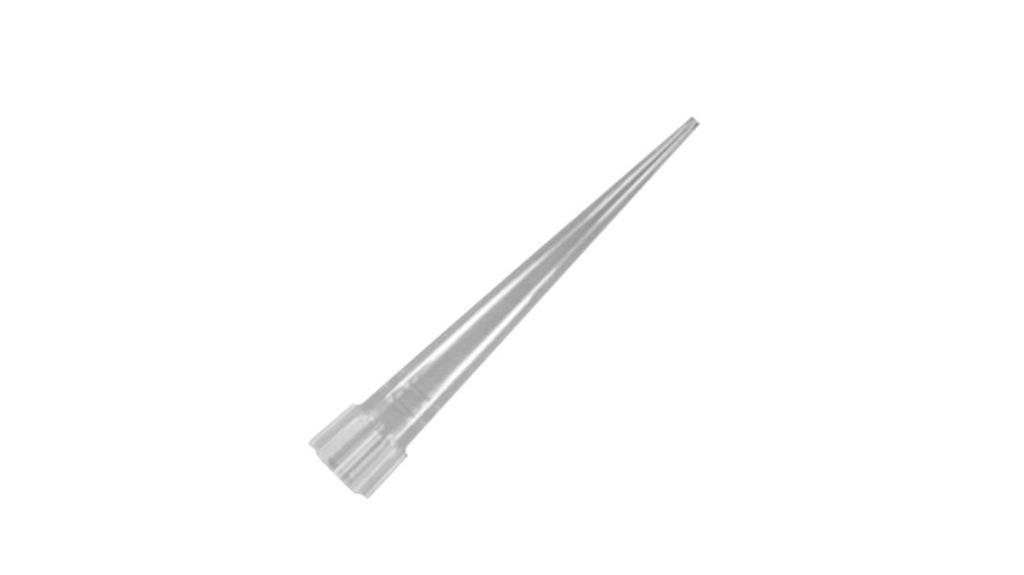
For laboratories seeking reliable and precise robotic pipetting, the Axygen OT-205-WB-R Robotic Pipet Tips are an excellent choice, especially when integrated with the Oasis automated liquid handling system. These 200-microliter, wide-bore tips are made from high-quality polypropylene and come in a racked configuration for easy handling. While non-sterile, they are designed specifically for automated systems to guarantee accurate and consistent pipetting performance. With packaging that includes 96 tips per rack, 10 racks per unit, and 5 units per case, they’re ideal for high-throughput tasks. Their compatibility and capacity make them a dependable option for precise liquid handling in the lab.
Best For: laboratories requiring reliable, high-throughput robotic pipetting with compatible, precise tips for automated liquid handling systems like Oasis.
Pros:
- Designed specifically for Oasis automated liquid handling systems, ensuring seamless compatibility
- Wide bore design minimizes sample retention and improves pipetting accuracy
- Racked, non-sterile packaging allows for easy handling and efficient workflow
Cons:
- Non-sterile, which may not be suitable for applications requiring sterile tips
- Limited to 200 microliters capacity, not adaptable for larger or smaller volume needs
- Racked configuration may require additional handling steps for certain automated systems
FOUR ES Scientific Adjustable Volume Micropipette (1-10ml)
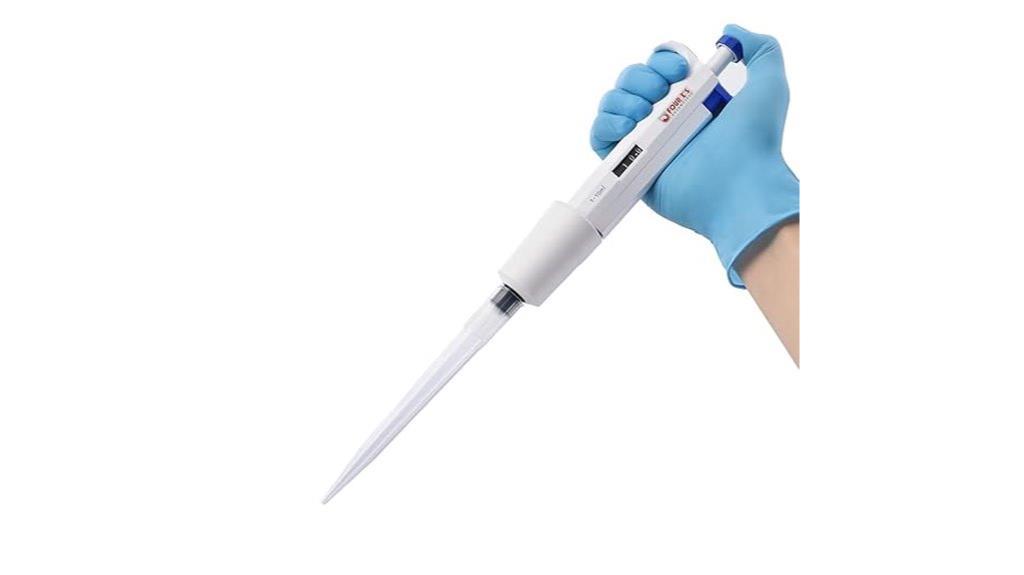
If you’re seeking a versatile micropipette that combines precise volume control with user comfort, the FOUR ES Scientific Adjustable Volume Micropipette (1-10ml) stands out. Its 1-10 ml range with 100 μl increments allows for accurate measurements across various applications. The digit display makes setting volumes quick and easy, while the lightweight handle reduces fatigue during prolonged use. Designed to resist chemicals and autoclave at 121°C, it ensures durability and sterility. Professionally calibrated and ISO8655 compliant, it guarantees precision. Whether in laboratories, industrial settings, or hobbyist projects, this micropipette offers reliable performance and user-friendly operation.
Best For: researchers, lab technicians, and hobbyists needing precise, adjustable liquid measurement in laboratory, industrial, or home settings.
Pros:
- Accurate volume control with professional calibration and ISO8655 compliance
- Comfortable, lightweight handle reduces fatigue during extended use
- Autoclavable design with chemical resistance ensures durability and sterility
Cons:
- Requires cooling and drying for 12 hours after autoclaving, which may delay sterilization processes
- Limited volume range (1-10 ml) may necessitate multiple pipettes for very small or very large volumes
- Increment setting of 100 μl might be less precise for applications needing smaller adjustments
ONiLAB Electric Pipette Controller, Adjustable Motorized Pipettor
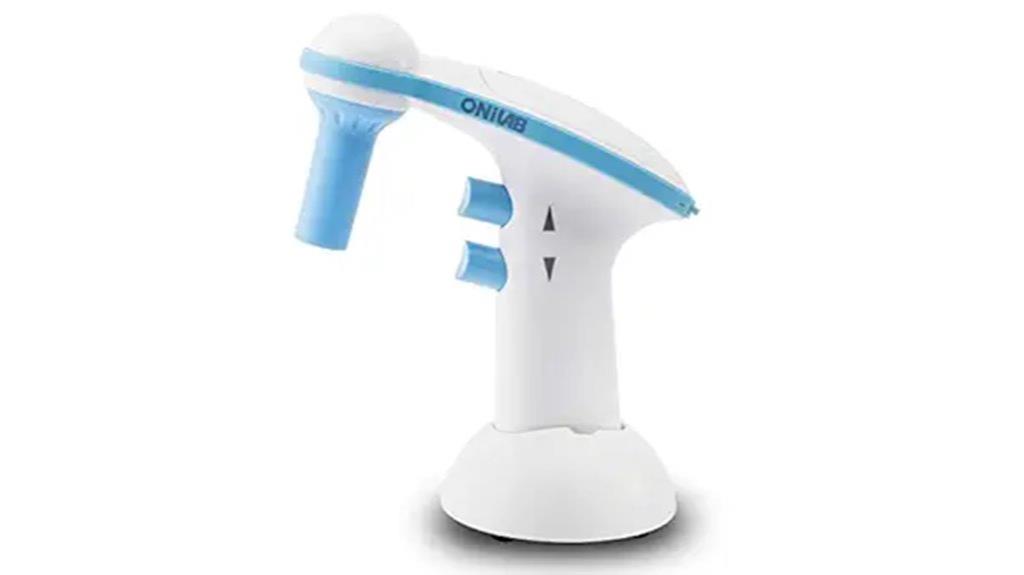
The ONiLAB Electric Pipette Controller stands out for its ergonomic, lightweight design, making it ideal for users who need precise, single-handed operation with minimal effort. Its stable base holder with dual placement options and rechargeable socket offers convenience and flexibility. Crafted from durable ASA and PC materials, it includes an autoclavable silicone adapter for sterilization. The adjustable speed wheel allows fine control over aspiration and dispensing, with rapid filling in about 10 seconds at maximum speed. Quiet and low-vibration, it supports both gravity and motor blowing modes. Powered by a long-lasting battery, it ensures reliable performance for over 8 hours, making pipetting faster and easier.
Best For: researchers and laboratory technicians seeking a precise, ergonomic, and easy-to-use electric pipette controller for handling a wide range of liquid volumes with minimal effort.
Pros:
- Ergonomic, lightweight design allows comfortable single-handed operation.
- Adjustable speed wheel provides precise control over aspiration and dispensing.
- Compatible with various pipettes from 0.1ml to 100ml, enhancing versatility.
Cons:
- Battery life, while over 8 hours, requires regular recharging for continuous use.
- May be less suitable for very high-volume pipetting tasks exceeding 100ml.
- Dependence on battery performance means performance may vary if not properly maintained or recharged.
Bonvoisin Electric Pipette Controller (0.1-100ml)
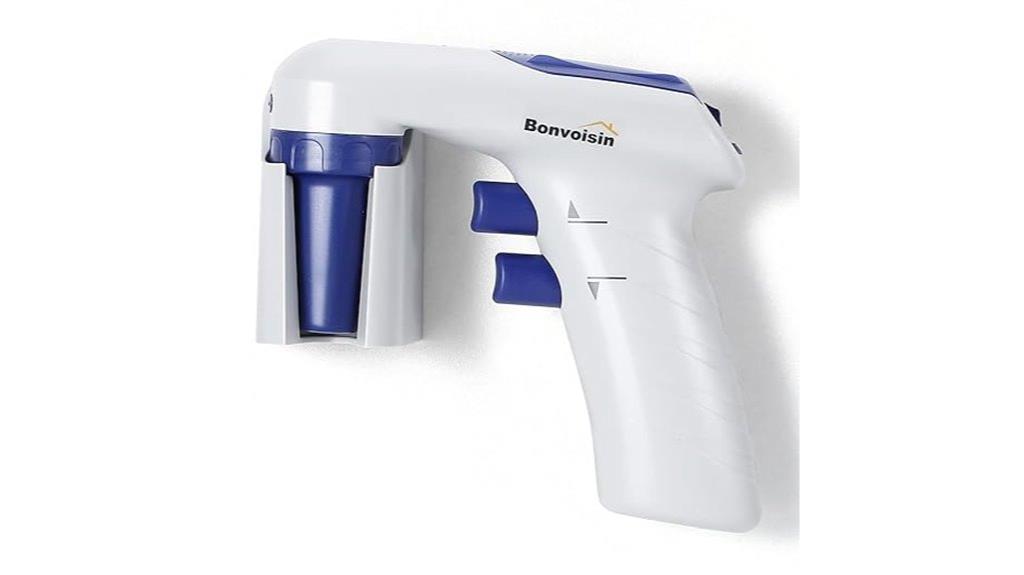
The Bonvoisin Electric Pipette Controller stands out as an affordable and user-friendly option for small laboratories, medical offices, and students who need precise liquid handling without investing in high-end equipment. It offers a measuring range of 0.1-100ml and pipetting speeds up to 50ml in under 10 seconds. The device features adjustable speed, gravity and motor blow-out modes, and comes with filters to prevent damage. Rechargeable in 2-3 hours, it supports around 8 hours of intermittent use. While suitable for limited use and light professional tasks, some users note durability issues over long-term heavy use. It’s an excellent budget choice for occasional, careful pipetting.
Best For: those seeking an affordable, easy-to-use electric pipette controller for occasional laboratory or medical tasks, especially students and hobbyists.
Pros:
- Cost-effective alternative to high-end pipettors, offering good value for budget-conscious users
- Easy to operate with an intuitive interface, suitable for beginners and interns
- Rechargeable battery supports up to 8 hours of intermittent use after a quick 2-3 hour charge
Cons:
- Durability concerns with some users reporting failures after about two weeks of heavy use
- Not designed for demanding, continuous, or mission-critical applications
- Limited to light professional or occasional use, may not withstand heavy, long-term operation
ONiLAB Pipette Pump Set of 3 Lab Pipettes
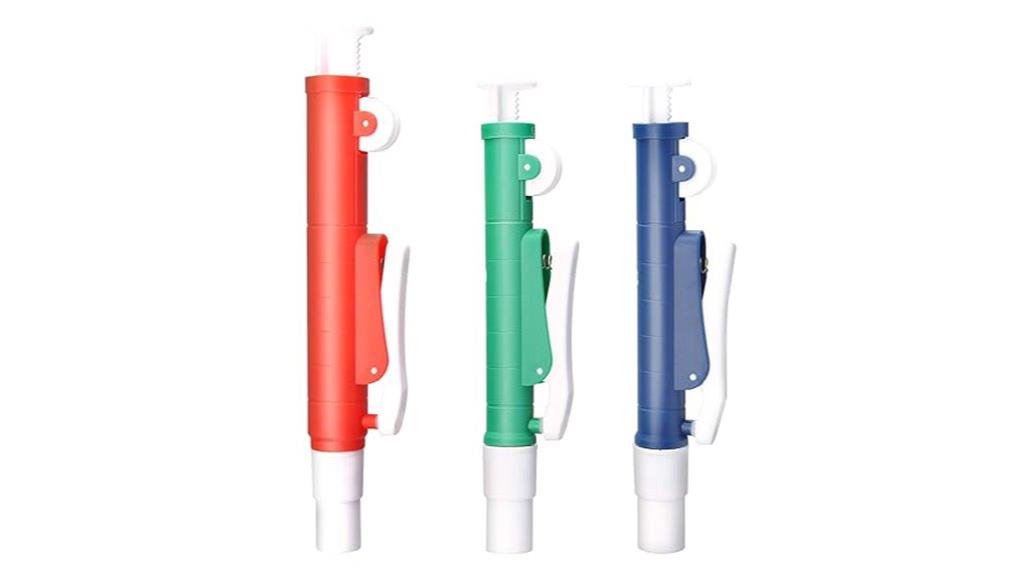
Ideal for small-scale laboratory and educational settings, the ONiLAB Pipette Pump Set of 3 Lab Pipettes offers versatile volume options and easy single-handed operation. The set includes 2ml (Blue), 10ml (Green), and 25ml (Red) pumps, compatible with both plastic and glass pipettes. Designed for precision and durability, they feature a thumbwheel for simple volume adjustments and are made from acid- and alkali-resistant materials. These pumps are easy to disassemble, clean, and maintain, ensuring consistent performance. While some users report minor quality issues, overall, they provide accurate liquid handling and are a reliable, cost-effective choice for various laboratory tasks.
Best For: small-scale laboratory, educational environments, and plant nutrient measurement tasks requiring precise liquid handling with versatile pipette compatibility.
Pros:
- Easy single-handed operation with thumbwheel design for precise volume adjustments
- Compatible with both plastic and glass pipettes of various sizes
- Made from acid- and alkali-resistant materials ensuring durability and high accuracy
Cons:
- Some units may arrive with broken components or defective seals requiring inspection or replacement
- Occasional reports of wobbly pipettes needing retightening or loose parts
- Variability in build quality could impact long-term performance and reliability
Factors to Consider When Choosing Automated Pipetting Systems
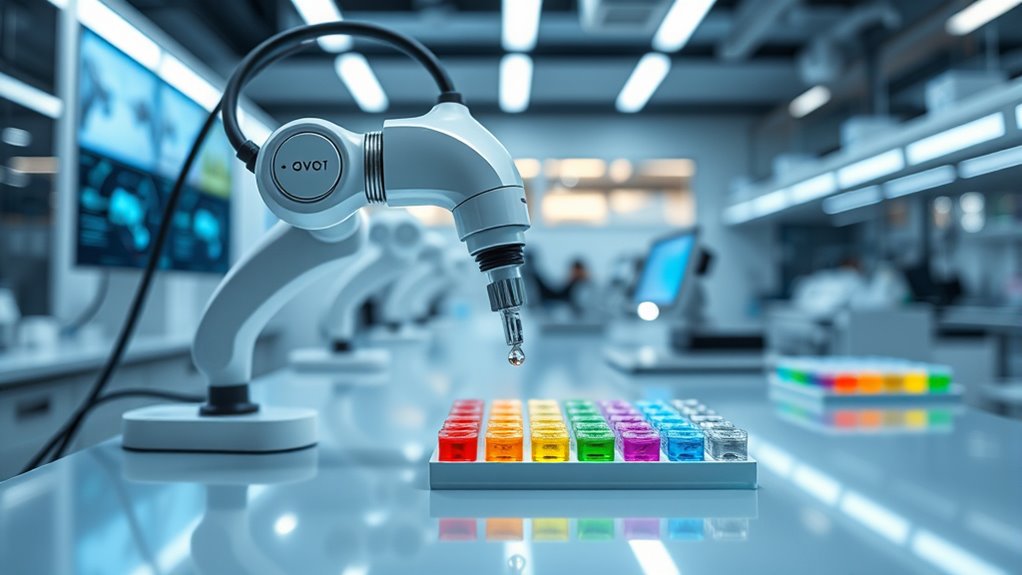
When selecting an automated pipetting system, I focus on key factors like volume range compatibility and precision to guarantee it meets my lab’s needs. I also consider how easy it is to calibrate and maintain, especially with features like auto-disinfection. Additionally, I evaluate power options to find a reliable setup that fits my workspace and workflow.
Volume Range Compatibility
Choosing an automated pipetting system requires careful attention to its volume range compatibility to guarantee it meets your laboratory’s specific needs. You want to ensure the system can handle your typical sample sizes without over- or under-utilizing its capabilities. Verify that it can accurately dispense the minimum and maximum volumes you work with, such as 0.5μl to 10ml. Flexibility is key, so look for systems with adjustable volume settings, preferably with fine increments like 50μl steps, for precise control. Additionally, consider whether the device supports multiple pipette sizes or ranges, which provides versatility across different protocols. Confirming compatibility with standard pipette tips and diverse measurement ranges ensures smooth operation and broad application suitability, ultimately enhancing your lab’s efficiency and accuracy.
Precision and Accuracy
Ensuring precise and accurate liquid handling is essential for reliable experimental results, which is why regular calibration of automated pipetting systems is crucial. Proper calibration ensures the system consistently delivers volumes within the ISO8655 standards, typically within a ±1-2% margin of error. Features like digital displays, fine volume adjustments, and feedback mechanisms help improve precision. High-quality systems utilize advanced sensors and motor controls to reduce variability caused by environmental factors and user handling. Routine performance testing and certification validate that the pipetting system maintains its accuracy over time. When selecting an automated pipettor, look for these calibration capabilities and validation options to ensure your experiments remain accurate and reproducible, saving time and reducing costly errors.
Ease of Calibration
Selecting an automated pipetting system with user-friendly calibration procedures is essential for maintaining accuracy without requiring specialized training. I look for systems that offer straightforward calibration routines, ideally with built-in features or automated processes that minimize human error. Regular calibration checks are crucial, especially after maintenance or tip changes, to ensure consistent performance. I also prioritize systems that provide clear calibration instructions and compatibility with calibration tools, making it easier to verify volume accuracy through standardized tests. Certified calibration documentation adds confidence in measurement reliability. An intuitive setup helps streamline the calibration process, saving time and reducing mistakes. Overall, choosing a system with accessible calibration features ensures ongoing precision, reproducibility, and ease of operation—key factors for efficient laboratory workflows.
Auto-Disinfection Features
Automated pipetting systems with auto-disinfection features actively improve laboratory hygiene by automatically sterilizing components between uses. These systems typically use UV sterilization, chemical disinfectants, or high-temperature autoclaving to guarantee tips, nozzles, and internal parts remain free of contaminants. Disinfection routines can be scheduled at regular intervals or after each pipetting cycle, maintaining consistent sterilization without manual effort. Incorporating auto-disinfection enhances safety by reducing exposure to hazardous biological materials and minimizes the need for manual cleaning. Additionally, regular disinfection helps preserve the lifespan of pipetting components by preventing residue buildup and microbial growth, ensuring ongoing accuracy and reliability. When choosing an automated system, consider how these disinfection capabilities align with your lab’s hygiene and safety standards.
Power Source Options
Choosing the right power source for an automated pipetting system depends on your laboratory’s specific needs and workflow. Battery-powered systems offer portability and are perfect for fieldwork or locations with limited power access. They typically provide around 8 hours of intermittent use per charge, making them flexible for on-the-go tasks. Conversely, AC-powered systems deliver consistent, reliable power suitable for high-throughput labs that require continuous operation. Some models combine both options, allowing users to switch between power sources based on the situation. The choice impacts operational convenience, mobility, and workflow efficiency. If your work involves movement or remote locations, batteries are advantageous. For steady, long-duration tasks, AC power ensures uninterrupted performance. Consider your environment and workload when selecting the best power source for your needs.
User Interface Design
A well-designed user interface is essential for maximizing efficiency and minimizing errors when working with pipetting systems. An intuitive interface with clear display options helps streamline workflow and reduces user mistakes. Touchscreen controls and customizable settings allow for quick volume adjustments and protocol programming, cutting down setup time. Visual indicators, like LED lights or digital prompts, offer instant feedback on system status and alerts, ensuring smooth operation. An ergonomic layout, with accessible buttons, minimizes operator fatigue during prolonged use. Compatibility with software supporting data logging and protocol customization enhances accuracy and traceability in lab workflows. Overall, a user-friendly interface not only speeds up processes but also improves reliability, making it a critical factor when selecting automated pipetting systems.
Frequently Asked Questions
How Do Automated Pipetting Systems Ensure Sample Cross-Contamination Prevention?
Automated pipetting systems prevent sample cross-contamination through a combination of high-precision disposable tips, rigorous cleaning protocols, and advanced liquid handling technology. I trust these systems because they use tip sterilization, dedicated channels for different samples, and software safeguards to avoid overlaps. These features work together to guarantee each sample remains pure and uncontaminated, giving me confidence in the accuracy and reliability of my experimental results.
What Maintenance Is Required for Long-Term Automated Pipetting System Reliability?
To keep my automated pipetting system reliable over the long term, I regularly clean and calibrate the components, especially the pipette tips and probes. I also perform routine software updates and check for leaks or wear. Replacing worn parts promptly guarantees accuracy. By following these maintenance steps, I prevent breakdowns, extend the system’s lifespan, and maintain precise, consistent results in my lab work.
Are There Compatibility Issues With Existing Laboratory Automation Equipment?
Compatibility can be a concern when integrating new automated pipetting systems with existing lab equipment. I always recommend checking the specifications and communication protocols beforehand. Sometimes, software or hardware mismatches can cause hiccups. To avoid issues, I suggest consulting with vendors about compatibility and possibly updating or calibrating existing devices. Proper planning guarantees smooth integration, saving time and maintaining lab efficiency.
How Do Automated Systems Handle Variable Liquid Viscosities Efficiently?
Sometimes, it feels like handling variable liquid viscosities is a challenge, but automated systems make it seamless. They adapt by using advanced sensors and customizable pipetting parameters, ensuring precise aspiration and dispensing regardless of viscosity. I’ve seen these systems adjust in real-time, maintaining accuracy and efficiency. This flexibility allows laboratories to work confidently with diverse liquids, turning a potentially complex task into a straightforward process.
What Training Is Needed for Staff to Operate Advanced Pipetting Automation?
To operate advanced pipetting automation, I recommend thorough training that covers system setup, calibration, and troubleshooting. Staff should learn software interfaces, liquid handling principles, and safety protocols. Hands-on practice is essential to build confidence and ensure precision. I also emphasize ongoing education to stay updated on new features and maintenance procedures. Proper training minimizes errors, boosts efficiency, and maximizes the system’s capabilities.
Conclusion
Choosing the right automated pipetting system is like finding the perfect compass in a sea of options—each one guiding you closer to precision and efficiency. As you navigate this landscape, remember that the best tool will feel like an extension of your hand, turning complex tasks into a smooth, symphonic dance. With the right system, you’ll transform your lab work from a rocky voyage into a steady voyage across calm, productive waters.
